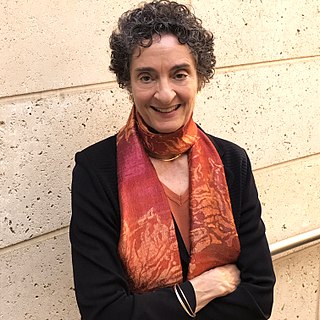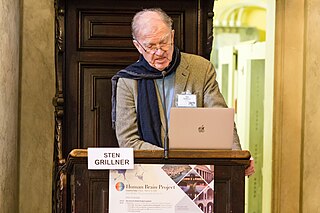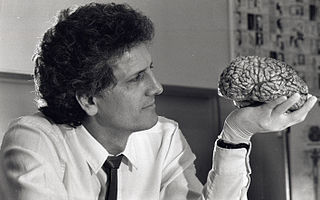
Neuroscience is the scientific study of the nervous system, its functions and disorders. It is a multidisciplinary science that combines physiology, anatomy, molecular biology, developmental biology, cytology, psychology, physics, computer science, chemistry, medicine, statistics, and mathematical modeling to understand the fundamental and emergent properties of neurons, glia and neural circuits. The understanding of the biological basis of learning, memory, behavior, perception, and consciousness has been described by Eric Kandel as the "epic challenge" of the biological sciences.

Carla J. Shatz is an American neurobiologist and an elected member of the American Academy of Arts and Sciences, the American Philosophical Society, the National Academy of Sciences, and the National Academy of Medicine.

Patricia Goldman-Rakic was an American professor of neuroscience, neurology, psychiatry and psychology at Yale University School of Medicine. She pioneered multidisciplinary research of the prefrontal cortex and working memory.

The Gruber Foundation is a philanthropic foundation established by Peter and Patricia Gruber and is based at Yale University in New Haven, Connecticut. Its mission is to honor and encourage excellence in the fields of cosmology, genetics, neuroscience, justice, and women's rights, which encompasses three major programmatic initiatives: the Gruber Prizes and the Young Scientists Awards; the Gruber Science Fellowship Program; and the Gruber Program for Global Justice and Women's Rights at Yale Law School.

The Kavli Prize was established in 2005 as a joint venture of the Norwegian Academy of Science and Letters, the Norwegian Ministry of Education and Research, and the Kavli Foundation. It honors, supports, and recognizes scientists for outstanding work in the fields of astrophysics, nanoscience and neuroscience. Three prizes are awarded every second year. Each of the three Kavli Prizes consists of a gold medal, a scroll, and a cash award of US$1,000,000. The medal has a diameter of 70 millimetres (2.8 in), a thickness of 5 millimetres (0.20 in), and weighs 311 grams (11.0 oz).
Viktor Hamburger was a German-American professor and embryologist. His collaboration with neuroscientist Rita Levi-Montalcini resulted in the discovery of nerve growth factor. In 1951 he and Howard Hamilton published a standardized stage series to describe chicken embryo development, now called the Hamburger-Hamilton stages. He was considered "one of the most influential neuroembryologists of the twentieth century".

Sten Grillner is a Swedish neurophysiologist and distinguished professor at the Karolinska Institute's Nobel Institute for Neurophysiology in Stockholm where he is the director of that institute. He is considered one of the world's foremost experts in the cellular bases of motor behaviour. His research is focused on understanding the cellular bases of motor behaviour; in particular, he has shown how neuronal circuits in the spine help control rhythmic movements, such as those needed for locomotion. He is the current secretary general of the International Brain Research Organization (IBRO) and president of the Federation of European Neuroscience Societies (FENS). For his work, in 2008 he was awarded the $1 million Kavli Prize for deciphering the basic mechanisms which govern the development and functioning of the networks of cells in the brain and spinal cord. This prize distinguish the recipient from the Nobel prizes in basic medical sciences.
Nikos K. Logothetis is a Greek biologist and neuroscientist. Logothetis studies visual perception and object recognition; he is well-known for his work demonstrating that BOLD fMRI data is related to neuronal activity. Logothetis directed the department of Physiology of Cognitive Processes at the Max Planck Institute for Biological Cybernetics in Tübingen from 1996 to 2020. He will co-direct the International Center for Primate Brain Research in Shanghai beginning in late 2020 or early 2021.
The British Neuroscience Association (BNA) is a scientific society with around 2,500 members. Starting out as an informal gathering of scientists meeting at the Black Hourse Public House in London to discuss brain-related topics, on the 23rd of February 1968 it was formerly established as the Brain Research Association, and subsequently relaunched as the British Neuroscience Association in 1997.
The W. Alden Spencer Award is awarded to an investigator in recognition of outstanding research contributions by the College of Physicians and Surgeons, the Department of Neuroscience, and The Kavli Institute for Brain Science at Columbia University. It is named after W. Alden Spencer, a Professor of Physiology and Neurology at Columbia University. The award winner also gives a lecture. In 2018, it took place at on October 9, 2018.
Bernice Grafstein Shanet is a Canadian neurophysiologist, a professor at Weill Cornell Medical College in New York and a noted specialist in neuroregeneration research. Shanet is a Professor of Physiology and Biophysics at Weill Cornell Medical College, the holder of the Vincent and Brooke Astor Distinguished Professorship in Neuroscience at Weill Cornell Medical College, the Professor of Neuroscience for the Brain and Mind Research Institute at Weill Cornell Medical College and the first woman ever to serve as president of the American Society for Neuroscience. Shanet is famous for her studies of the transport of materials down the axon nerves and her thesis work on the mechanism of cortical spreading depression, which became a classic in its field and is acknowledged even today.
Robert H. Wurtz is an American neuroscientist working as a NIH Distinguished Scientist and Chief of the Section on Visuomotor Integration at the National Eye Institute. He is a member of the US National Academy of Sciences and the American Academy of Arts and Sciences. He is recognised for developing methods for studying the visual system in 'awake-behaving' primates, a technique now widely used for the study of higher brain functions. He pioneered the study of the neuronal basis of vision and its relation with cognitive functions.
Roger A. Nicoll is an American neuroscientist at the University of California, San Francisco where he is professor at the Department of Cellular and Molecular Pharmacology.

John O'Keefe, is an American-British neuroscientist, psychologist and a professor at the Sainsbury Wellcome Centre for Neural Circuits and Behaviour and the Research Department of Cell and Developmental Biology at University College London. He discovered place cells in the hippocampus, and that they show a specific kind of temporal coding in the form of theta phase precession. He shared the Nobel Prize in Physiology or Medicine in 2014, together with May-Britt Moser and Edvard Moser; he has received several other awards. He has worked at University College London for his entire career, but also held a part-time chair at the Norwegian University of Science and Technology at the behest of his Norwegian collaborators, the Mosers.
The Karl Spencer Lashley Award is awarded by The American Philosophical Society as a recognition of research on the integrative neuroscience of behavior. The award was established in 1957 by a gift from Dr. Karl Spencer Lashley.

George Paxinos AO DSc FASSA FAA FRSN FAHMS is a Greek Australian neuroscientist, born in Ithaca, Greece. He completed his BA in psychology at the University of California at Berkeley and his PhD at McGill University in Montreal, Canada. After a postdoctoral year at Yale University, he moved to the School of Psychology of the University of New South Wales in Sydney, Australia. He is currently an NHMRC Senior Principal Research Fellow at Neuroscience Research Australia and Scientia Professor of Medical Sciences at the University of New South Wales.

Marina Rachel Picciotto is an American neuroscientist known for her work on the role of nicotine in addiction, memory, and reward behaviors. She is the Charles B. G. Murphy Professor of Psychiatry and professor in the Child Study Center and the Departments of Neuroscience and of Pharmacology at the Yale University School of Medicine. Since 2015, she has been editor-in-chief of the Journal of Neuroscience.
The Ralph W. Gerard Award of the Society for Neuroscience (SfN) is an award in neuroscience awarded annually since 1978 for Lifetime Achievement. It is the highest recognition conferred by the SfN. As of 2018, the prize winner receives US$25,000.
Tim P. Vogels is a professor of theoretical neuroscience and research leader at the Institute of Science and Technology Austria. He is primarily known for his scholarly contributions to the study of neuronal plasticity related to learning and memory in the brain.
The IBRO Dargut and Milena Kemali International Prize for Research in the field of Basic and Clinical Neurosciences' is a prize awarded every two years to an outstanding researcher, under 45 years old, who made important contributions in the field of Basic and Clinical Neurosciences. The award was established in 1998.








